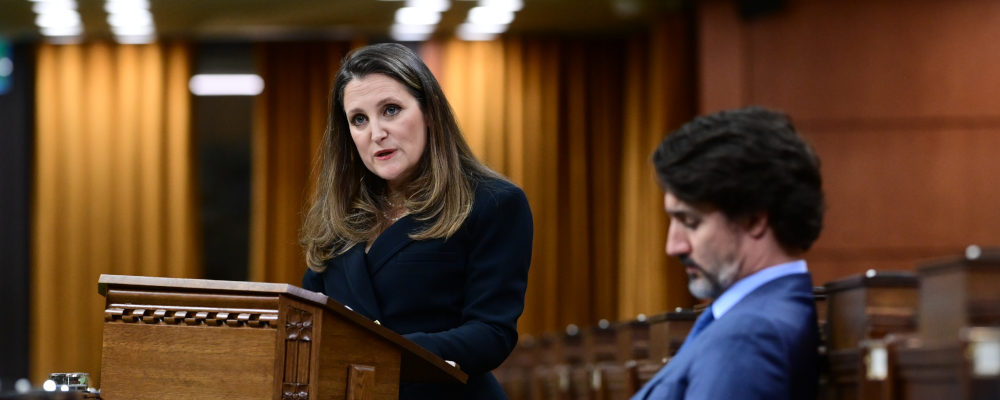There is a conventional narrative of a “professional woman” that has informed the Canadian definition of success and in turn shaped most of the current Liberal government’s female-focused public policy.
It goes like this: a young woman graduates university, climbs the professional ladder in a relatively short period of time, pauses briefly to have children in her mid-20s, achieves professional success just shy of 50, and retires at about 70-years-old. She is of course in a committed relationship, most likely to man, and lives a 15-minute drive from her parents.
She certainly exists and she may align with the Liberal worldview, but not all women fit this mould and not all women are Liberal.
In 2015, when Justin Trudeau stood with 15 men and 15 women on either side of him to reveal his gender equal cabinet, I was encouraged. But in the past six years, my feminist credo, and that of my prime minister, has been challenged. We have both been confronted by the realities of what it means to be a woman in the workplace.
Trudeau’s government has used a gender-based analysis plus (GBA+) framework in policymaking, which assesses how women, men, and non-binary people experience programs, policies, and initiatives. GBA+ is sensible — policymakers ought to consider the people they are making the policy for — but the problem is that women (and men for that matter) are not a monolithic group.
For example, the government’s promised $30 billion national daycare system is admirable in its approach, but the policy does not address the many women who do shift work, have multiple jobs, or simply work long hours.
Following COVID-19, policymakers can no longer afford to apply GBA+ to individual policymaking and be satisfied that they have checked the “woman” box. To achieve a #FeministRecovery and improve gender-equality in the workplace long-term, the Trudeau government needs to make a genuine commitment to rooting their policy-making in the real-world experiences of different Canadian women.
It would be disappointing if the pro-female progress fell victim to the ‘spend now, cut later’ doctrine.
There are a couple of examples in Budget 2021 where the Liberals almost get this right.
First is the proposal that Crown corporations be required to implement gender and diversity reporting starting in 2022. The disclosure of public data and key metrics can hold companies accountable and enable young women to make informed decisions about where they want to work. Recent public reporting of gender metrics has led to real culture change at one major Toronto law firm.
This transparency in the workplace should be non-negotiable and the mandate should extend to the private sector. For example, the government plans to spend $80 million over three years to help teach kids to code. I like to imagine that one day my future daughter will be able to code — but it would be even better if she could look forward to employment with confidence, knowing her prospective employer has historically promoted both men and women at an equal clip.
The second area of achievement is procurement. To increase diversity in procurement, Budget 2021 proposes to leverage supplier diversity opportunities through domestic procurement, running competitions from equity-deserving groups. Mandating that women-owned companies be part of Canada’s procurement process or that companies seeking government RFPs achieve and report their workplace’s gender-diversity are two ways the government can build a more inclusive economy by design.
While both programs are not shout-from-the-rooftop “Re-elect me!” policies, they are meaningful ways to address the realities that professional women face. There is little accountability or incentive for companies to address gender inequality and the companies women own are least likely to receive government contracts. These policies have potential to address systemic gender inequalities in the workplace and to make a real difference for women long-term.
Increasingly, my peers and I look to our employers to support our life decisions, seeking work at companies and organizations that purport to not only have generous maternity and paternity leaves, but that also offer childcare support and fertility treatments such as egg-freezing as part of corporate benefit plans. Allowing women to plan and have “control” over the biological clock empowers them to have children without having to take a foot off the professional ladder.
There is no doubt the Liberal government continues to own the feminist narrative in comparison to their political counterparts. In Budget 2021, supports for women extended beyond the workplace and include important funding for the Women Entrepreneurship Strategy, a National Institute for Women’s Health Research, access to reproductive health care information and services, and funding for a National Action Plan to End Gender-Based Violence. Neatly, each of these policies favour women most significantly on the GBA+summary chart.
There is over $100-billion in new spending in Budget 2021 and Trudeau’s promise to run deficits is one he has kept. It would be disappointing if the prime minister underestimated the political cost of borrowing and the pro-female progress made in the budget fell victim to the “spend now, cut later” doctrine.
That said, if an opposition party, like Erin O’Toole’s Conservatives, moved away from conventional narratives to create policies that acknowledge and empower women to make choices that work for their own professional trajectories — reordering conventional rungs or hitting pause on traditional trajectories — there might just be a path to the ever-needed women’s vote.
Letting women know that the government has included gender equality by design and acknowledging new realities in policy is paramount. Canada’s future prosperity and competitiveness depends on encouraging young women to redefine the arc of a successful career and enabling them to take control of their professional trajectory, whether they conform to the prototypical Liberal image or not.




